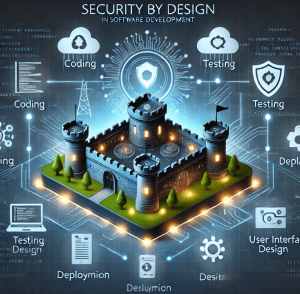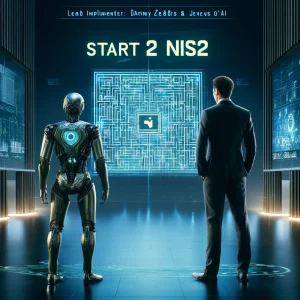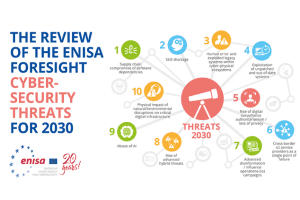The Achilles’ heel of an organization that in most cases leads to a (GDPR) data leak are CRM systems and help desk software.
In almost every company we audited, these environments are set up for ease of use. In doing so, they often create a gray area that exposes personal data to accidental loss.
A list of support tickets containing first name, name , email and ip address is often considered not GDPR related. This thinking is wrong. If one of your employees emails such a list to the wrong email recipient , you will have to explain it to the data protection authority and your story will be publicly pilloried.
So if you are looking forward to improving your data leakage policy and want to demonstrate zero trust in your NIS2 policy you should consider looking out for applications that use blockchain.
Blockchain technology can enhance security and data protection in Customer Relationship Management (CRM) systems in several key ways:
Decentralization: Traditional CRM systems store data on centralized servers, making them attractive targets for hackers. Blockchain’s decentralized nature distributes data across a network of computers, reducing the risk of data breaches. Each node in the network has a copy of the entire database, making it much harder for unauthorized access or alterations to occur unnoticed.
Cryptography: Blockchain uses advanced cryptographic techniques to secure data transactions. Each block of data is securely linked to the previous one through cryptographic hashes. This ensures that once a transaction is recorded, it cannot be altered without changing every subsequent block, which is practically impossible without the consensus of the network.
Transparency with Privacy: Blockchain offers a unique combination of transparency and privacy. While all transactions are transparent and verifiable by all participants, the data itself can be encrypted to protect sensitive information. This means stakeholders can verify transactions without compromising the privacy of the data contained within them.
Data Integrity and Traceability: The immutability of blockchain ensures that once data is entered, it cannot be tampered with. This feature enhances trust in the data’s integrity, as every transaction is recorded chronologically and securely. Moreover, the traceability of transactions makes it easier to track customer interactions and histories securely.
Smart Contracts: These are self-executing contracts with the terms of the agreement directly written into lines of code. In a CRM context, smart contracts can automate and secure routine tasks, such as verifying identity or processing transactions, without the need for intermediaries. This not only increases efficiency but also significantly reduces the risk of fraud.
Improved Compliance and Control: Blockchain can help companies better comply with data protection regulations. By providing a transparent and secure way to store data, companies can ensure that they meet stringent data protection standards. Additionally, blockchain can give individuals more control over their personal information, allowing them to decide who has access to their data and for what purpose, aligning with GDPR and other privacy regulations.
Resistance to DDoS Attacks: The decentralized nature of blockchain makes CRM systems more resilient to Distributed Denial of Service (DDoS) attacks. Since there is no single point of failure, it’s much more difficult for attackers to target and compromise the system’s availability.
Identity Verification: Blockchain can enhance the security of customer identity verification processes. By using blockchain-based digital IDs, CRM systems can ensure that customer data is associated with verified identities, reducing the risk of identity theft and fraudulent activities.
But! Implementing blockchain in CRM systems is not without challenges, including integration with existing systems, scalability, and regulatory considerations. However, its potential for enhancing security and data protection makes it a promising technology for the future of CRM.
Key pillars to keep in mind:
- Revolutionizing Trust and Customer Relationships
- Enhanced Transparency and Security
- Decentralization for Resilience
- Secure Storage of Customer Data
- Verified Customer Profiles
- Smart Contracts for Streamlining Operations
- Facilitating Loyalty Programs and Rewards
Further reading:
Understanding Blockchain CRM: Building Trust and Nurturing Customer Relationships (ciolook.com)
Use Cases for Blockchain in Business and Industry | Salesforce
Do or do not there is no try!
Most companies fail in project management and forget that the budget for a saas application for business critical processes can be spent only every ten years.
Want some insight how to conduct a good feasibility study?
Project management by Qfirst
Conducting a feasibility study for adopting cloud software, with a focus on security as a crucial pillar, involves a structured approach that encompasses technical, financial, and legal aspects. Here’s a step-by-step guide to ensure a thorough and effective evaluation:
Define the Scope and Objectives
Identify Business Needs: Understand and document the specific business requirements that the cloud software needs to address.
Security Objectives: Clearly define what security means for your organization, including data privacy, compliance requirements, and risk management.
Research Potential Cloud Solutions
Market Analysis: Research the available cloud software options that meet your initial criteria, focusing on their security features and compliance with relevant standards (e.g., ISO 27001, GDPR).
Vendor Reputation: Evaluate the reputation of the cloud service providers, including their security measures, incident response history, and customer feedback.
Technical Assessment
Architecture Review: Understand the architecture of the cloud solutions and assess how they align with your company’s existing infrastructure and security requirements.
Security Features: Examine the specific security features offered, such as encryption methods, identity and access management (IAM), network security controls, and data protection mechanisms.
Compliance and Certifications: Verify the cloud provider’s compliance with industry standards and regulations relevant to your business.
Risk Analysis
Identify Risks: Identify security risks associated with moving to the cloud, including data breaches, loss of control over data, and compliance risks.
Risk Mitigation Strategies: Plan for mitigating identified risks, such as through contractual agreements, adopting additional security measures, or ensuring insurance coverage.
Cost Analysis
Direct Costs: Calculate the direct costs associated with the cloud software, including subscription fees, migration costs, and any needed training.
Cost of Security Measures: Include the cost of additional security measures your company may need to implement internally or pay for as part of the cloud service.
Cost-Benefit Analysis: Compare the total cost against the expected benefits, taking into account potential cost savings from reduced IT infrastructure and improved efficiency.
Legal and Regulatory Compliance
Data Protection Laws: Ensure the cloud solution complies with data protection laws applicable to your company, such as GDPR for companies handling EU citizens’ data.
Contractual Agreements: Review contractual agreements with the cloud service provider, focusing on their terms regarding data ownership, security responsibilities, and liability in the event of a security breach.
Stakeholder Engagement
Internal Stakeholders: Engage with internal stakeholders, including IT, legal, finance, and business units, to gather input and ensure their needs and concerns are addressed.
External Consultants: Consider hiring external consultants with expertise in cloud computing and security to provide an unbiased assessment.
Pilot Testing
Conduct a Pilot: If feasible, conduct a pilot test with the cloud software to evaluate its performance, security, and compatibility with your business processes.
Feedback and Adjustments: Collect feedback from pilot users and make necessary adjustments before a full-scale rollout.
Make an Informed Decision
Evaluate Findings: Review all collected information, assessments, and pilot test results to make an informed decision on the feasibility of adopting the cloud software.
Decision Documentation: Document the decision-making process, including the rationale, expected benefits, and planned security measures, for future reference.
Implementation Planning
If the decision is to proceed, develop a detailed implementation plan that includes timelines, security measures, staff training, and a rollout strategy to ensure a smooth transition to the cloud software.
This article was composed with the help of Cyberbutler.AI












